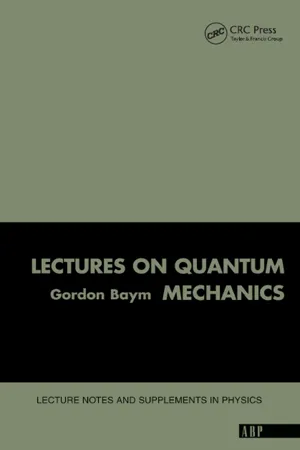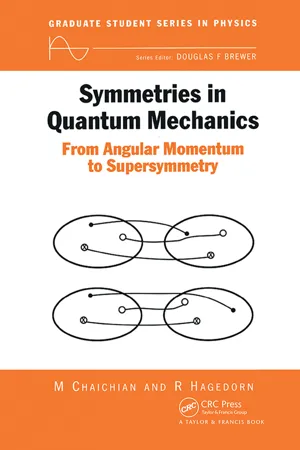Physics
Rotation Operator
A rotation operator is a mathematical tool used to describe the rotation of an object in three-dimensional space. It is often represented by a matrix or a set of equations that can be used to calculate the new position and orientation of an object after a rotation. In physics, rotation operators are fundamental for understanding the behavior of rotating bodies and systems.
Written by Perlego with AI-assistance
Related key terms
Related key terms
1 of 4
Related key terms
1 of 3
3 Key excerpts on "Rotation Operator"
- eBook - ePub
- A C Sharma(Author)
- 2021(Publication Date)
- CRC Press(Publisher)
point x + (δ θ z) y, y − (δ θ z) x. 4.4 Quantum Generalization of the Rotation Operator It is well known that in quantum mechanics orbital angular momentum is not the total angular momentum. It is found experimentally that particles like the electron exhibit an internal angular momentum, called spin angular momentum. The total angular momentum, called J, is the sum of the orbital angular momentum L and spin angular momentum S J = L + S The operator J is defined as the generator of rotations on any wave function, including possible spin components. Therefore, Eqn. (4.16b) is generalized to: R (δ θ) ψ (r) = e − i δ θ. J / ℏ ψ (r) (4.20) which is similar to the equation for L, whose components are written as differentials. Up to this point, we considered ψ (r) a complex valued function of position. But the wave function at a point can have several components in some vector space. The Rotation Operator will operate in that space, and it is a differential operator too with respect to position. Then, the state vector ψ is a vector at each point, and the rotation of the system rotates this vector as well as moving it to a different value of r. The ψ in general, has n -components at each point in space; R (δ θ) is then a n × n matrix in the component space, and Eqn. (4.20) is the definition of J in that component space. This definition is used to study the properties of J. For an infinitesimal angle ε, we can write: R x (ε) ≃ 1 − i ℏ ε J x ; R y (ε) ≃ 1 − i ℏ ε J y and R z (ε 2) ≃ 1 − i ℏ ε 2 J x, which on substituting into Eqn. (4.15b) yield: 1 − i ℏ ε J x 1 − i ℏ ε J y − 1 − i ℏ ε 2 J z 1 − i ℏ ε J y 1 − i ℏ ε J x ψ = 0 (4.21) All the zeroth and first-order terms in ε cancel, and the second-order term gives: J x, J y = i ℏ J z (4.22a) which is generalized to: J i, J j = i ℏ ε i j k J k (4.22b) where the. symbol ε i j k is equal to +1, if i j k take values in cyclic order (123, 231, 312) and it is equal to −1 when i j k take values that are not in cyclic order - eBook - ePub
- Gordon Baym(Author)
- 2018(Publication Date)
- CRC Press(Publisher)
(17-4) . We can similarly study the transformation properties of operators under rotations. By the transformation of an operator A under a rotation ω we mean the unitary transformation:A →R ωAR ω– 1(17-48) (Cf. Eq. (6-15) , for a similar transformation by the inverse rotation.) The expectation value of an operator A in a state |Φ〉 is the same as the expectation value of the “rotated” operatorin the rotated state Rω |Φ〉.R ωAR ω– 1Certain operators are scalars under rotation; this means that they commute with the total angular momentum J and are unchanged by the transformation (17-48) . Then there are operators, such as the three components of the position operator x, y, z, that transform among themselves under rotation like the components of a vector. Other operators, such as px 5 z + y, for example, have no nice transformation properties under rotation. The types of operators having simple transformation properties under rotation are known generally as tensor operators. By an irreducible tensor operator T(k) of order k we shall mean a set of 2k + 1 operatorsT q, q = –k, –k + 1,…, k – 1, k, that transform among themselves under rotation according to the transformation law( k )R ωT q( k )R ω=– 1∑kq ′= -kTq ′( k )dq ′q( k )( ω );(17-49) This transformation law is the equivalent for operators of Eq. (17-4) . An irreducible tensor T(0) is clearly a scalar, while one of older 1 is a vector; the components Tq (1) are linear combinations (which we shall construct shortly) of the x, y, and z components of the vector. Thecoefficients are the matrix elements of the irreducible representation of the rotation group of dimension 2k + 1. It follows from the irreducibility of the d(k) matrices that there is no subset of components,dq ′q( k )( ω )T q, or linear combination of components, that transforms among itself privately under rotations; this is why a tensor operator transforming according to (17-49) is called irreducible. [Later we shall meet reducible tensor operators.]( k )If we consider an infinitesimal rotation ε, thenR ε=e≈ 1 ––i J⋅ εi J⋅ ε ,(17-50) and the transformation law (17-49) becomes, to first order in ε - eBook - ePub
Symmetries in Quantum Mechanics
From Angular Momentum to Supersymmetry (PBK)
- M Chaichian, R Hagedorn(Authors)
- 2023(Publication Date)
- CRC Press(Publisher)
4 Angular Momentum Operators and Eigenstates4.1 The operators of angular momentum J1 , J2 and J3
4.1.1 The physical significance of J
We know that the three operators Jk are Hermitian and (in a rotationally invariant system) commute with the Hamiltonian; therefore they are observable constants of the motion. We shall now find out what their physical significance is. As we know from classical mechanics, the constant of the motion arising from rotational invariance is the angular momentum. We naturally expect the same here.It is clearly sufficient to establish the physical significance of J3 , since that of J2 and J1 follows then simply from the supposed symmetry (and, to be pedantic, a permutation of x, y and z).We consider a spinless particle in a state |ψ〉. Its Schrodinger function is(4.1.1)before and after an active rotation respectively.If we rotate the physical system by the infinitesimal angle η about the z-axis, then the r.h.s. of (4.1.1) becomes(4.1.2)This is the wave function of the new state at the old position x. What happens to the l.h.s. of (4.1.1)? We must calculate the value of the new wave function at the old position (see figure 4.1 ). The whole wave function is bodily rotated by the angle η. Therefore, if Ra is the rotation, the value of ψ at the point P = (x, y, z) is carried to the point Ra P, while its value at the point is carried to the point P where it becomes ψ′(P). Therefore the new wave function at the point P is equal to the old one at the pointR a. In symbols− 1Figure 4.1. Rotation of a wave function.The last part of this equation says that we have to calculate ψ at a point with those coordinates which would result from rotation by +η of the coordinate system. According to (3.3.5) we have then ψ′(x, y, z) = ψ(x′y′, z′) where for the considered infinitesimal rotation x′ = Mp
Index pages curate the most relevant extracts from our library of academic textbooks. They’ve been created using an in-house natural language model (NLM), each adding context and meaning to key research topics.
Explore more topic indexes
Explore more topic indexes
1 of 6
Explore more topic indexes
1 of 4


